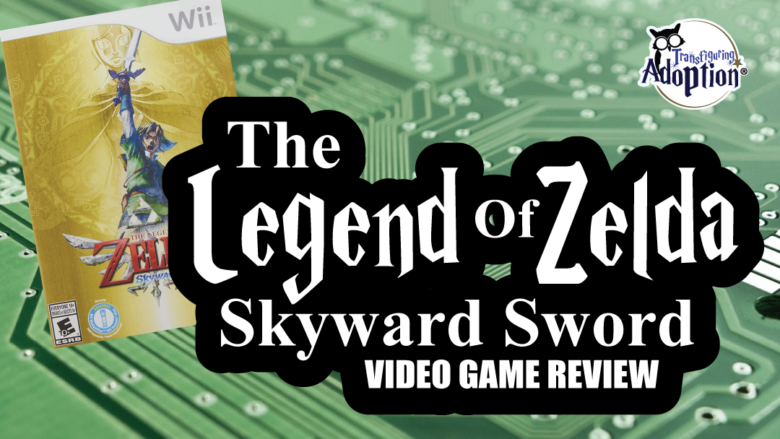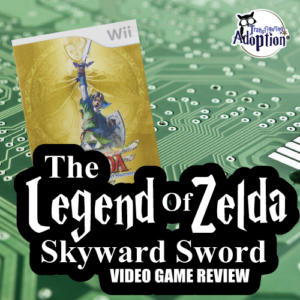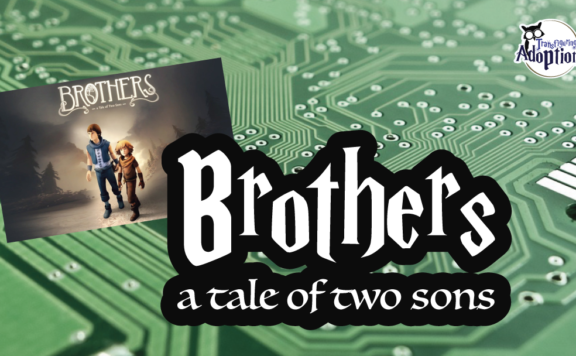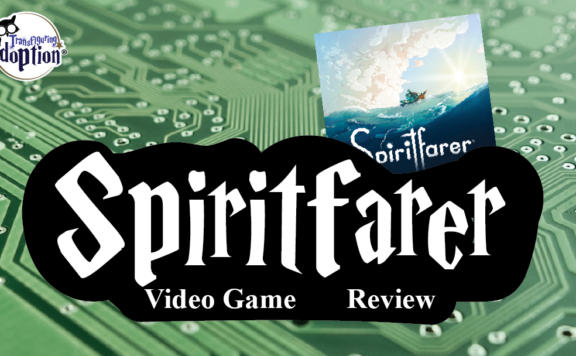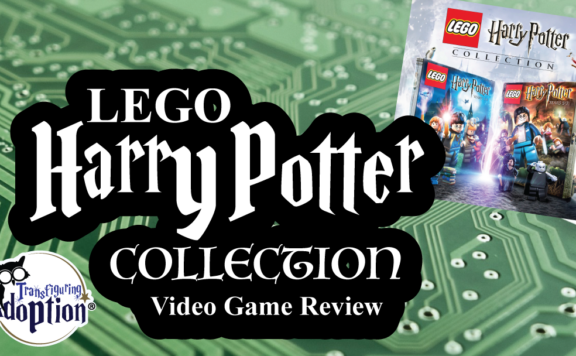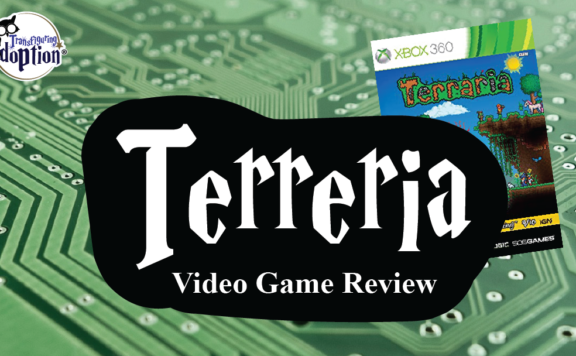[Download PDF Guide]
Grade:
Transfiguring Adoption awarded this game 3 Hoots out of 5 based on how useful it will be for a foster/adoptive family. [Learn more about our Hoot grading system here]
Game Info:
- Rating: ESRB E for Everyone 10+ (for Animated Blood, Comic Mischief, Fantasy Violence), PEGI 12+ (for violence)
- Genre: Action, Adventure, Narrative, Open World, Physically Active and Role-Playing
- Platform(s): Wii (original 2011), Nintendo Switch (HD rerelease 2021)
- Studio: Nintendo EAD
From the Cover Synopsis of The Legend of Zelda: Skyward Sword HD (2021) by Nintendo:
“Take to the skies, draw your sword, and experience the earliest story in the Legend of Zelda series. Join Link in his high-flying quest to save Zelda, a childhood friend who much confront her destiny.
Soar between floating islands and descend to the treacherous surface courl in this updated HD version of The Legend of Zelda: Skyward Sword game. Gently swing your Sword and angle your slashes to uncover and break through opponents’ defenses using intuitive motion controls. Movements feel smoother and more immediate thanks to the Nintendo Switch system’s processing power and HD graphics. Take advantage of the newly-added button only control scheme – perfect for playing in handheld mode or on the Nintendo Switch Lite system.”
Transfiguring Adoption’s Overview:
The target audience for this game appears to be children that are 10-12 and up. While the game doesn’t have the dark aesthetic of other Zelda titles (i.e. – The Legend of Zelda: Twilight Princess, The Legend of Zelda: Majora’s Mask, etc.) there are a couple moments of jump scares and fantasy violence that may spook more jumpy-kiddos. If you are a gamer and remember the Silent Realm (unique to the Skyward Sword version of Hyrule) this in particular may be a bit suspenseful for some younger players. Additionally, the controls are a bit more complex due to the controls being nunchuck-centered in the Wii version so some of your children may prefer to use a console controller for the Nintendo Switch HD edition. It also appears this game would be best for most families to play together.
While there are no overt themes relating to adoption or foster care, Link is a character that most children can see them as. Since Link doesn’t really talk and is ambiguous enough it is easy for children to see themselves in Link (or whatever they decide to name him). There are times too where the player can select the degree of reaction Link has to other characters, giving him a personal spin. Link does not appear to have parents in this game, and is sort of raised by his community so children from adoptive or foster backgrounds may also resonate sometimes with having a more unique circle of support.
While there do not appear to be any harmful stereotypes, there is not a lot of diversity or representation. Most of the human-like characters are Hylian (appearing as white, elf-like humans). There is one character that could be coded as neurodivergent involved in an insect sidequest but this is not very overt nor is he a primary character. There are other intelligent communities in the game but most of them resemble animals or objects more than humans.
** Spoilers Could Be Ahead **
How Is This Relevant To Adoption & Foster Care?
In this installment of The Legend of Zelda series Skyward Sword is set as a prequel to all the games that have been released to date (2021). This was a game created to explain the origin of the triforce and much of the lore explored in other games. Link in many games is featured as a youth that does not live with any identifiable parents, and this one is no exception. Throughout the game no blood-relatives are featured or referenced and this indicates that Link was likely orphaned and raised by the residents of Skyloft. He specifically appears to live in Skyloft’s Knight Academy and is supervised by Headmaster Gaepora and instructors Horwell and Owlan along with other students. During the start of gameplay it’s clear that Skyloft is a tightly-knit community as all the residents know Link well and frequently aid him in his journey.
While this does not directly correlate with foster care or adoption, many children with traumatic backgrounds are familiar with having supports from beyond the family of origin. Whether they have been “adopted” by sports coaches, neighbors, or church groups or have been placed in foster or adopted care many children that have encountered the system have either already or need to learn how to access positive supports within their circles of influence. Having additional natural supports is always a benefit to a child growing up, but this can be a matter of survival for children that lack some levels of supports from their family of origin. Connection to others is not an innate skill either, but one often taught to us by our primary caregivers so children with trauma often lack some of the skills needed to identify positive connections and then access the support these connections may offer. For this reason this game can be a conversation starter about forming positive relationships and identifying safe connections.
Another positive aspect of this game is there is no risk of cyberbullying or contacting strangers in this game at all, which is a refreshing feature to this game. While most games for the Nintendo Switch have features accessible through the Nintendo Switch Online pass this installment does not have online features so your child or youth may have a bit more freedom with this specific game of play without this risk.
Discussion Points:
- Identifying Positive Connections
Throughout Link’s adventure he comes across a variety of people and creatures. Some of these people or creatures “look” nice. Some baddies and monsters “look” bad. These sometimes are easier to identify which may be friend or foe. However, during the course of the game there are sometimes folks that may be so easy to identify as good/bad. One example is the side quest featuring Batreaux. Batreaux is a scary-looking demon that very much wishes to be human. He is introduced to you by a young girl in Skyloft named Kukiel (who sweetly calls him “Uncle Bats”). Batreaux very much looks just like one of the traditional bad-guys in the game but is really a sweet guy and sends you on missions to collect Gratitude Crystals by doing good deeds for others. Just like Batreaux, sometimes it’s easy to judge a book by his cover or by our past experiences. For children with trauma, due to abuses and neglect that have occurred at the hands of adults all adults may look like Batreaux. For this reason caregivers should refrain from taking it for granted that their children will automatically trust them or that a child can safely decipher safe vs. unsafe relationships and make sure to take time to teach a child how to judge relationships appropriately.
- Forming Appropriate Relationships
How do you make connections with others? If you think about it, a lot of your experiences with making friends or connections with others were likely modeled by how you watched your parents or other trusted adults interact with others, and then were refined with practice with your peers. For children with trauma though there may be a lack of those experiences in their development so social awkwardness and deficits in emotional intelligence may cause your child to need some extra guidance in making friends with their peers. Some of Link’s interactions with others are easy, like the ones in Skyloft where he grew up and knows everyone. While on the surface though, while everyone speaks a common language there are lots of differences in how the various residents of the Surface interact and show respect. Like Link, your child is constantly trying to adapt and learn how to interact with folks in very different ways than they are used to including cultural differences. - Asking for Help
When a child has been through trauma there are some skills that they may miss out on building. This is especially true for social skills and interpersonal skills that are developed while interacting with safe, attuned adults or supervised with peers. It may seem like a given but for a child that has learned that adults are unreliable at best asking for help can be a huge ask. For this reason caregivers often need to teach their children how to ask for help when they struggle rather than struggling until complete frustration and meltdown. Like Link, we as human beings cannot experience life alone in a vacuum. Link is definitely a huge hero for this game but there is no way he could have faced all of the trials and challenges without the help of others like Fi, his professors, his neighbors, the new friends he makes on the surface, and even Groose. So, like Link, your child will need gentle guidance and reminders to ask for help when needed.
Cautionary Points:
- Cartoon Violence
Throughout the game there are lots of sequences with cartoon violence. Most of this is pretty low-key in terms of graphics as there is no blood, brain-matter, or dismemberment of human-like characters so this should be a low-level trigger. However, if your child has had a lot of use of their limbic systems due to toxic stress and trauma they may struggle with the excitement of wielding a sword, bows and arrows, and even bombs and become more prone to aggression due to being unable to differentiate their brain’s response to excitement from danger so caregivers should still check in frequently with their child to ensure they are having fun without overwhelming their cortisol and adrenaline-filled bodies and brains. - Suspenseful Gameplay/Jump Scares
These are not as numerous as other games, but there are a few cinematic jump scares to build suspense and draw the player in emotionally. Just like the cartoon violence warning, this can trigger the limbic system and for a child that overuses the stress activation systems due to trauma or toxic stress may be more reactive to such scenes than most children and may need additional support while playing the game.
- Comic Mischief
Throughout the game there are sequences of toilet humor — quite literally. There is a sidequest that involves a ghostly woman in a toilet and giving her paper for… well, you know. This is an old gag from previous Zelda games (i.e. – Majora’s Mask, Oracle of Ages, etc.) that older gamers may note but a parent may not appreciate so much. There are other sequences of slap-stick type humor sprinkled in but this is also a low-level trigger concern.
- Scary Monsters
True to most Zelda installments there are lots of enemies to fight in this game. Most of the monsters are fairly cartoonish compared to games like The Legend of Zelda: Twilight Princess (2006/2016) but a few of them are especially creepy… Personally I found the Silent Realm Guardians to be the most suspenseful and creepy but every kid will have their own fears and triggers. There are some monsters, including a boss, that are spider-like among other creepy things so caregivers with kiddos sensitive to creepy bosses may need to step in for some help periodically.
Discussion Guide:
- When Link first meets Batreaux (pronounced Bat-row), what did you think he was? How did you think he’d respond to Link?
Caregiver Note: This is a good opening question to open up the conversation about identifying positive connections. In studying behavior humans often engage in the “Halo Effect” which is a bias or stereotype that good looking people are good. In turn this means that often humans are wired to initially see someone scary and associate them with being scary or not trustworthy. Over time most folks hopefully grow up and learn from caregivers that we cannot judge a good or bad book by its cover but kids with trauma may miss out on that very important lesson. By seeing how poor Batreaux is really a sweet, kind character in spite of his demonic-exterior this can help open up a conversation about this. - What could have happened if Link assumed Batreaux was a bad guy? How would Kukiel have felt if her friend was hurt?
Caregiver Note: If Link had jumped in with sword blazing poor, innocent Batreaux could have been really hurt and Kukiel could have lost a friend. So often it is tempting for people to make decisions on others without taking time to take in the facts. The facts we learn about Batreaux are that he can’t help the way he looks, he wishes he didn’t scare people, he wants friends, and one of his few friends is Kukiel. None of that could be deciphered by looking at Batreaux so it’s very important that Link did not immediately attack him because he looks “bad”. - How did Link find out the truth about Batreaux?
Caregiver Note: Link was able to decipher if Batreaux was a good guy based on Kukiel’s experience with him, how consistently caring he has been towards Kukiel, how appropriate he was with Kukiel, encouraging kindness to others, and in his interaction with gratitude crystals. While gratitude crystals cannot measure good vibes with others in real life, there are some good talking points for deciphering if someone is a positive influence as opposed to negative (like pre-character development Groose). - Who are Link’s closest friends? Who are other people Link trusts and that he has a lot of help from?
Caregiver Note: It’s pretty clear from the beginning that Zelda and his loftwing are likely Link’s closest friends at the start of the game. Link shows this by his familiarity with them, the amount of time he spends with them, and how much he divulges about himself to them. Link also seems to trust Headmaster Gaepora, Professors Horwell and Owlan, and the Knights of the Skyloft Academy. These are all people that have spent a significant amount of time with Link and teaching him how to become an honorable Knight to represent the Academy and protect Skyloft and certainly seemed to contribute to his preparation for heroism. This is important as many children with trauma may not have such extensive networks of support built in around them. Especially for children that have moved about the child welfare system or due to adoption there may be a large lack of supports and appropriate relationships to help a child model forming appropriate relationships with peers or safe adults so a caregiver will often have to step in to help make connections and teach how to form appropriate relationships with close friends, peers, and safe adults. - How does Link form relationships with the Kikwis, Parella, Goron, and others he meets on the surface?
Caregiver Note: While Link doesn’t mind jumping in to help the folks he meets, it’s clear he doesn’t immediately jump into close friendships with everyone he meets. Over time with lots of consistency, talking, and exchanging of greetings and information Link is able to develop amicable relationships with most of the folks he meets on the surface (well, except that one robot that calls him “Master Shortpants”). Children that have been through trauma are often so desperate for love and connection that they may over share or over-perform in hopes of garnering new connections and friends so showing a child that a slower progression is totally normal and fine is a helpful way to teach your child that you don’t have to be best friends with someone overnight. - At first, Groose does not seem like a good connection. What is that?
Caregiver Note: As we see with Groose’s character development some folks can change and while we hope for good character development we don’t want to immediately trust just anyone. From the start we can see as the audience that Groose is exceedingly jealous of Link and often takes others for granted. Just look at how his room is spaced with Cawlin and Strich and you can see how much of a bully Groose is even to the people he likes. However, over time Groose learns that there is more at stake than Zelda’s affection and popularity among Skyloft after he falls to the Surface and has some life experience there. While we hope for growth like Groose it’s still important for our kids to learn to watch out for those that do not wish us well with behaviors like Groose shows. Help your child identify his bullying behavior, how he insults people, is a sore loser, pouts when he doesn’t get his way, and crosses boundaries inappropriately with Zelda, his friends, and his rivals.
- How did Groose change by the end of the game? How is he different?
Caregiver Note: Thankfully for Groose he does experience some character development by helping Link, connecting with those on the Surface, and being a lot kinder with no expectations in return. As a result he gained a large cult-following on the internet due to his wild Groose-isms and swagger. He also by the end of the game shows more of his own strengths once he stops comparing himself to Link and leans into his own interests like his contraption building for the fights against The Imprisoned. Children can learn from watching Groose that not only can others change, but so can they with time and learning about the world around them. - How does Link get so much help from everyone he meets?
Caregiver Note: This game is interesting for a Zelda game as in some scenarios it allows the player to respond in straightforward, nice ways or in sassy or sarcastic ways. While eventually Link usually will find help the way characters respond to him will vary based on his responses to questions and statements. Most often though the simplest way Link finds help is when he calmly listens and asks politely for help. This may seem like a no-brainer but for children with trauma this may not be a simple response. They may not have learned that adults are safe sources of help and care and may be more likely to bottle up their needs until they explode or walk into a social blunder. For this reason caregivers will need to be extra patient and offer lots of guidance and “re-dos” for kids that struggle with asking for help properly. - Could Link have completed the adventure without help from anyone? What would have happened if he didn’t have help?
Caregiver Note: This is simple, there is no way Link could have completed this adventure without the help of nearly every NPC in the game! If Link didn’t talk to other players he would lack the majority of the items he needed, especially since most of them cannot be bought in the few stores that exist. He couldn’t receive hints about how to traverse the various dungeons or defeat enemies. There are so many places where NPCs help even when danger isn’t present. Like Link, people need other people. We are social creatures that grow in the context of relationships. While not every relationship you have may yield rupees or a bomb bag, the relationships with cultivate affect how much we grow as people in developing social skills, emotional intelligence, and general knowledge of the world around us. This means that it is very important that we learn how to ask for and accept help as a life skill! - How can I make it easier for you to ask for help?
Caregiver Note: Allow your child to guide this part of the conversation and be prepared to hear things you may not like. A child may provide feedback that it’s hard to ask because of tone or posturing and while that may not be easy for us as caregivers to hear we do need to be mindful that our tones and postures may not convey being open to providing help and care especially in times where we are stressed, angry, or overwhelmed. Remember, take deep breaths and know that we all are constantly learning about how to best communicate with others around us. Even when we get older sometimes we may need a reminder of what we are communicating when we speak or not.
About the Reviewer: Rachael Rathe
Rachael B. Rathe is an East Tennessee native with a Bachelor of Arts Degree in Psychology with a Minor in Child & Family Studies from The University of Tennessee Knoxville. She has worked in mental health since 2013 and in foster care/adoptions for a private provider agency since 2014. Rachael was inspired to work in the field after working with children and teens on a volunteer basis 2008 – 2013. Rachael’s ideal self-care day involves snuggling on a couch with her kitties (Tabitha, Fergus, and Rufus) while enjoying a good movie or book. She also enjoys galivanting around conventions concerning all things nerd and geekery.
**Transfiguring Adoption is a nonprofit organization seeking to nurture growth in foster and adoptive families by giving a HOOT about their families. Transfiguring Adoption does not intend for its reviewers nor its review to be professional, medical or legal advice. These reviews and discussion guides are intended to help parents to better be able to connect and understand their children who come from traumatic backgrounds.
